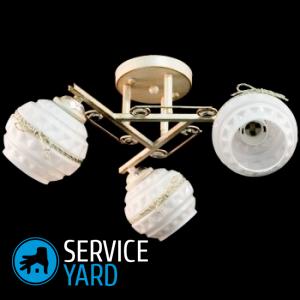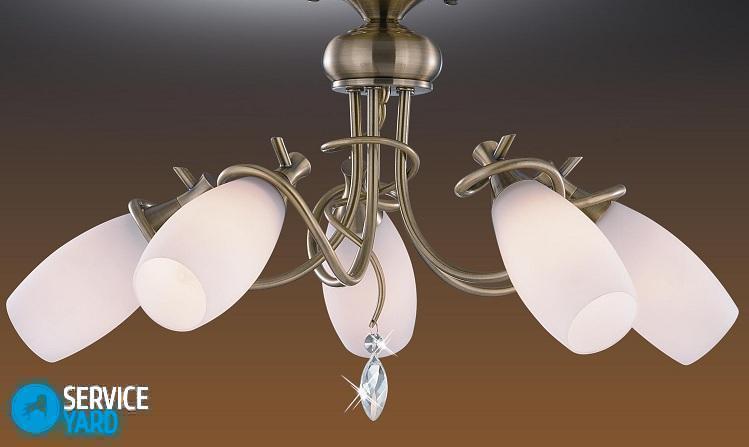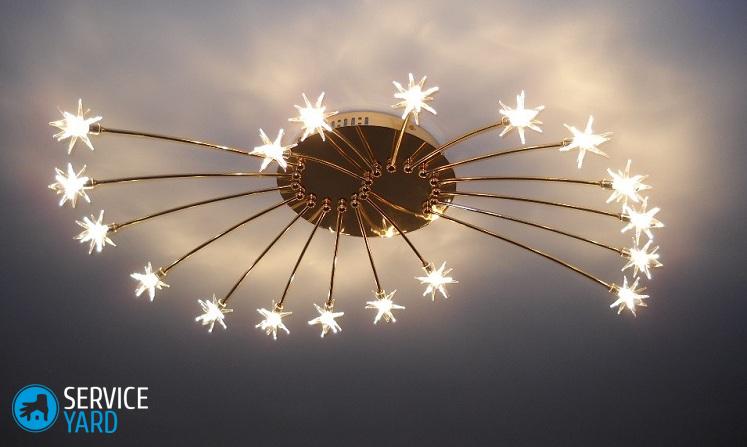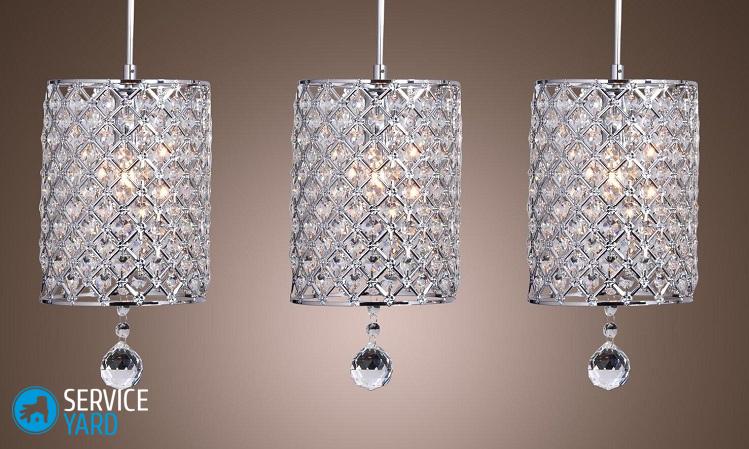How to assemble a chandelier?

Many owners of apartments and houses during the repair decide to change not only the decoration and design, but also the lamps. Today on sale it is rarely possible to find a chandelier consisting of one light bulb and a ceiling. Lighting manufacturers offer sophisticated designs with intricate designs, very luxurious and beautiful, but the trouble is, it is sometimes difficult to assemble this miracle of design thought. Most often, the instruction for the box with the packed parts of the lamp is not attached, and therefore, the owner of the shining beauty needs to solve the problem himself and answer the question of how to assemble the chandelier. However, do not despair, because, despite the variety of different types of lamps, the principle of assembly and connection of chandeliers is almost the same. If you once master the assembly scheme of the chandelier, you can cope with any lighting device, regardless of the number of horns, design features and other characteristics. Today, as an example, we will tell you how to assemble a chandelier with 3 lamps and 5 lamps, and consider the design of other lamps.
to contents ↑General arrangement of lamps and chandeliers
Before proceeding with the installation of lighting devices, consider their device. The lamp consists of the following parts:
- Shade The element performs, first of all, a protective role (closes an incandescent lamp), and secondly - a decorative function. The plafond is made of plastic, glass, metal. To get to the insides of any lamp, the ceiling must be removed. Depending on the mounting methods, the ceiling can be twisted, attached to the body using latches or bolts.
Important! The most common mount is plastic rings that are screwed onto the thread of the cartridge.
- Lamp. In lighting devices, various types of lamps can be used. Experts recommend using in the kitchen and in rooms energy saving - fluorescent lamps, and better - LED.
- Cartridge. An element may have a different design. In conventional ceiling lights, the lampholder is screwed to the housing with 2 bolts. In some models, the bolts can be immediately unscrewed, but in most models you must first disassemble the cartridge and remove the core.
- Reflector. In most models for home and apartment, it is not used. But it is very often used in office luminaires for the ceiling and in floodlights. A reflector with a white or mirror surface serves to create directional light.
- Power supply or trigger control device. If necessary, a power supply is installed in the housing, which is necessary for the operation of LED and fluorescent lamps. However, the popular energy-saving models for a conventional cartridge almost always come with a built-in circuit inside and simply screw in instead of incandescent bulbs.
How to assemble a lamp?
Lamps are:
- Suspended.
- Overhead.
- Recessed.
Important! Spotlights have gained great popularity recently. They appeared along with suspended ceilings and solved the issue of economical and competent lighting. Each recessed lamp gives a little light, its main advantage is mobility. You can install lights on the ceiling anywhere, anytime, in any quantity.
The luminaires come with a separately packed body and shade.Pendant and overhead lights are installed quite simply:
- Attach the housing.
- Connect the device to the power supply.
- Install the ceiling.
With spotlights and chandeliers, the situation is much more complicated. Below we dwell in more detail on the assembly of ceiling spotlights and tell you how to assemble a sconce and chandelier.
to contents ↑How to assemble a ceiling lamp?
Installation of a ceiling lamp is possible in:
- Suspended ceiling.
- Tensioning.
- Drywall.
- Rack and pinion.
In addition, spotlights can have a different design, for example, have a movable outer part, which allows you to direct the light in a certain direction.
The number of recessed spotlights is determined depending on the characteristics of the room:
- Area. If the area of the room is small (bath or toilet), then only one device is enough, if the room allows, then you can place lights around the perimeter of the ceiling.
- Layout.
- Color scheme.
Advice:
- The recessed downlight for the bathroom is different from other similar appliances. It is more suitable for use in high humidity conditions. The lamp does not allow water and steam to pass through glass or plastic located above the main part of the device. For fixtures designed for bathrooms, for safety reasons, use lamps whose power does not exceed 12-24 watts. In the event of a short circuit or other malfunctions, such lamps will not harm human health.
- When calculating the number of lamps for a room, be guided by the rule: 1 lamp per 1 sq. M. The distance between the devices should be about 30 cm, and the distance to the wall about 20 cm. Plan the installation locations of the devices in advance, before installing the suspended ceiling. It is necessary to conduct wires to the fixture attachment points, and in the case of a stretch ceiling, install fixing rings. Install and connect spotlights in the suspended ceiling at the end of the repair.
Important! Install ceiling lights in the bathroom with a transformer. To determine which transformer is needed, multiply the number of lamps by their power. The result will show the power of the required transformer.
Tools for work
To install a spotlight, you will need the following tools:
- Electric cable with clamps.
- Drill with a long drill.
- Round drill nozzle for making holes.
- Pliers.
- Screwdriver.
- Insulation tape.
- Junction box.
- Protective caps for electrical wiring.
- Nippers to remove insulation.
- Protective equipment: safety glasses, gloves.
Step-by-step instruction:
- Turn off the electricity in the room and make sure that the room is de-energized.
- Mark with a pencil the locations of the devices.
- Wear safety glasses and gloves.
- Cut a round hole of the required size in the ceiling (the device body should fit in the hole) using a drill and a round nozzle. The hole should be slightly smaller than the decorative exterior of the appliance.
Important! Do the holes in the plasterboard ceiling before puttying and finishing work.
- Route the cable from the power source to the junction box. To avoid additional hole expansion, use a drill with a long drill.
- Open the junction box and connect the cable in this way:
- Remove the top layer of insulation from the end of the cable.
- Connect the stripped wires to the wires of the box.
- Twist the wires as follows: black with black, white with white, ground with ground.
- Fasten the wires with pliers.
- Put the protective caps on the connected wires.
- Pack the wires in the box and close it with the lid.
- In the ceiling hole, install the base part of the device body (the junction box should go behind the ceiling panels). Many instrument designs are secured with clips that snap into place automatically.
- Install the bulb itself according to the manufacturer's instructions. The housing of each lamp is equipped with a fastener, with which it is easy to fix the final part.
- Connect the electricity and enjoy the light.
to contents ↑Important! Spotlights are installed in the stretch ceiling in the same way, only the holes are not drilled, but are cut inside the heat-resistant ring with a knife.
How to assemble a chandelier with 5 lamps?
We will divide the entire installation process into stages so that it will be easier for you to understand everything.
Preparatory stage
Before starting work, prepare the following tools:
- Wire stripper.
- Electric screwdriver.
- Screwdrivers or screwdriver with a set of bits.
- Wrench.
- Drill and drill with a victory tip (diameter 6mm) for mounting the mounting plate on a concrete or reinforced concrete ceiling. Installation on a plasterboard suspended ceiling can be carried out using self-tapping screws or a butterfly dowel.
After you have prepared the necessary tools, proceed as follows:
- Open the box with the lighting device. Do this carefully so as not to damage the parts. Factory products, as a rule, are supplied in blocks: case, shades, horns with shades for light bulbs, terminal blocks. Wires must be connected to all nodes.
Important! Do not forget to check the correspondence of the number of parts with the description of the model of the device. Check for completeness before starting installation.
- Fragile items (shades, remote control, light bulbs, etc.) set aside.
- Remove the remaining parts from the packaging.
The mechanical part of the assembly of the chandelier
Assemble the upper part of the central body of the device. Proceed as follows:
- Take a decorative “plate”.
- Place the plate on the chandelier shaft.
- Tighten the top nut.
Attach the horns to the body. Depending on the model and design of the device, the number of horns may be different. But the technology of their fastening remains unchanged. Proceed as follows to assemble a 5-lamp chandelier:
- Turn off a decorative nut and remove a protective cover from the central case of a chandelier.
- Take one of the horns, remove the nut and the counter washer from it.
- Insert the horn into the corresponding hole, secure with the removed nut and washer.
- In a similar way, install all the horns.
- Check the symmetrical arrangement of the horns relative to each other. If necessary, adjust their placement.
- Tighten the fixing nuts with a wrench.
Electrical part - connect the wires in the chandelier
This is the most crucial stage when you need to assemble a chandelier with 5 lamps. There are two connection options:
- To the single switch. In this case, all the lights will light up at the same time.
- To the double. With a five-arm lamp, you can plan to turn on two and three lamps separately, but for this you need to get another wire, since the manufacturer starts only two groups: phase and zero.
The grouping of wires depends on the type of connection. There will be 2 groups to a single switch, and 3 groups to a double switch. Cable separation is by color. Each outlet has 2 wires with different color insulation:
- Blue wires are zero.
- Browns are phase.
Important! First you need to work with wires of one color, for example, “phase”, and then - group wires of another color - “zero”.
Consider separately the connection to a single-key switch and to a double.
Connection of wires in a chandelier for a single-key switch
In this embodiment, the connection is very simple, since the phase and neutral wires are suitable for the chandelier and there are also two wires in each horn. Therefore, proceed as follows:
- Strip the first group of wires from insulation by 1-2 cm (phase).
- Connect them together.
- Strip and connect all the zero wires of the horns. You should get 2 groups of wires.
- Connect the wire groups to the main supply wire using the protective caps.It is not recommended to twist the wires without protective caps (connectors), since the contacts, remaining uninsulated, quickly oxidize, resulting in a short circuit.
- Similarly connect the second group of wires to another center wire.
- Carefully lay the wires in the housing.
- Close the bottom cover and tighten the decorative nut.
Important! For reliability, the place of twisting of wires can be soldered.
Chandelier assembled. All other decorative elements, shades and bulbs have not yet been put in place, since first you need to fix the chandelier to the ceiling and connect it to the power supply.
Connection of wires in a chandelier under a two-gang switch
First you need to divide the chandelier horns into two groups:
- If you have an even number of bulbs, then in this case it is very simple to separate them, for example, odd - 1 group, even - 2 group. Naturally, the zero wires will go into group 3. With this connection, harmony and symmetry will be achieved.
- If you have a five-arm chandelier, then symmetrically breaking the wires into two groups will not work. Here you will have to connect so that 3 buttons turn on with one button and the second one - 2. If you turn on both buttons at the same time, then all the lights will light up. Although, the options may be different.
So, let's get down to business:
- Distribute the wires: “zero” - into 1 group, phase - divide into two blocks, one will be connected to the horns 1, 3 and 5, and the second - to 2 and 4.
- Strip each wire group 1-2 cm from insulation.
- Connect all groups to the main power cable. The supply wire that enters the body of the chandelier must be necessarily three-wire. All zero (blue) wires are connected to one core, the wires of the 1st group are connected to the second, and the wires of the 2nd group are connected to the third.
- Insulate the junction points.
- Carefully lay all the wires in the housing, close the decorative bottom cover and tighten the nut.
- Install shades and decorative elements after connecting the chandelier.
to contents ↑Important! To get the third wire for the two-gang switch, completely disassemble the chandelier body. To do this, unscrew the upper one along with the lower decorative nut. Find the central rod into which the two-wire wire is connected from the factory, pull the plastic sealing rings from the ends and the wire. Get a three-wire wire (or just an additional wire of the same cross section). Secure the wires with sealing plastic rings from the ends.
Stock footage
We hope that our advice and simple recommendations helped you assemble the chandelier, even without the DIY manual. Fix the dazzling beauty on the ceiling and admire the light emanating from her!
- How to choose a vacuum cleaner taking into account the characteristics of the house and coatings?
- What to look for when choosing a water delivery
- How to quickly create comfort at home - tips for housewives
- How to choose the perfect TV - useful tips
- What to look for when choosing blinds
- What should be running shoes?
- What useful things can you buy in a hardware store
- Iphone 11 pro max review
- Than iPhone is better than Android smartphones






